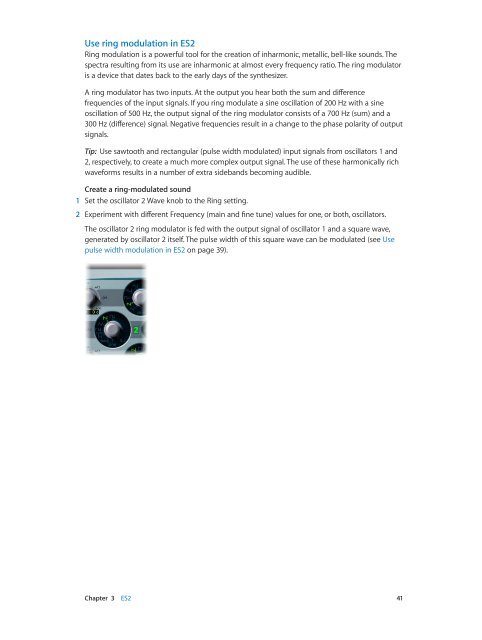Apple MainStage 3 Instruments - MainStage 3 Instruments
Apple MainStage 3 Instruments - MainStage 3 Instruments
Apple MainStage 3 Instruments - MainStage 3 Instruments
Create successful ePaper yourself
Turn your PDF publications into a flip-book with our unique Google optimized e-Paper software.
Use ring modulation in ES2<br />
Ring modulation is a powerful tool for the creation of inharmonic, metallic, bell-like sounds. The<br />
spectra resulting from its use are inharmonic at almost every frequency ratio. The ring modulator<br />
is a device that dates back to the early days of the synthesizer.<br />
A ring modulator has two inputs. At the output you hear both the sum and difference<br />
frequencies of the input signals. If you ring modulate a sine oscillation of 200 Hz with a sine<br />
oscillation of 500 Hz, the output signal of the ring modulator consists of a 700 Hz (sum) and a<br />
300 Hz (difference) signal. Negative frequencies result in a change to the phase polarity of output<br />
signals.<br />
Tip: Use sawtooth and rectangular (pulse width modulated) input signals from oscillators 1 and<br />
2, respectively, to create a much more complex output signal. The use of these harmonically rich<br />
waveforms results in a number of extra sidebands becoming audible.<br />
Create a ring-modulated sound<br />
1 Set the oscillator 2 Wave knob to the Ring setting.<br />
2 Experiment with different Frequency (main and fine tune) values for one, or both, oscillators.<br />
The oscillator 2 ring modulator is fed with the output signal of oscillator 1 and a square wave,<br />
generated by oscillator 2 itself. The pulse width of this square wave can be modulated (see Use<br />
pulse width modulation in ES2 on page 39).<br />
Chapter 3 ES2 41
















